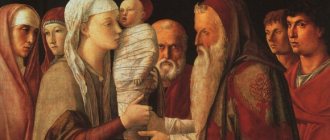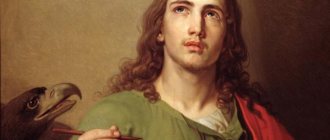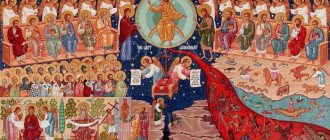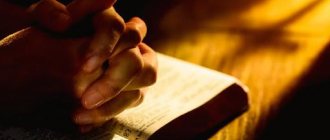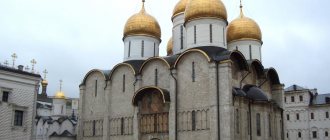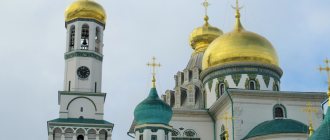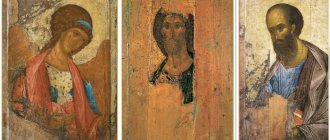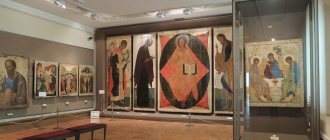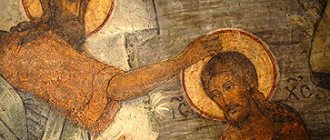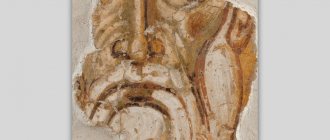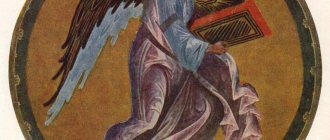The Baptism of the Lord is a solemn event that fills the soul of every Christian with light. Entering the waters of the Jordan River, the Savior took the first step towards his destiny. Taking part in the rite of baptism, he emphasizes his involvement with ordinary people, repentant, erring people, takes on their sins and promises purification. Many icons are dedicated to this sacred event. We’ll talk about one of them – the “Baptism of the Lord” icon from the workshop of Andrei Rublev – today.
To the depths of centuries
All evangelists talk about this significant event. While Jesus and his family lived in Nazareth, the prophet John proclaimed his imminent coming in the Judean desert. He called on people to repent of their sins, wash them away in the waters of the Jordan River and start a new life according to Christian covenants.
When the Savior turned 30 years old, he came to the site of the ceremony to reveal his true nature to the world. John, recognizing the son of God, doubted his right to baptize him. But Jesus reassured the old man, explaining that this was the will of his Father. Entering the waters, he prayed for blessings on the difficult journey. At this time, the Holy Spirit descended from heaven in the form of a dove, and all those present heard the voice of God: “This is My beloved Son, in whom I am well pleased.” From that day on, the Savior began to fulfill his mission, terrible and great.
Folk customs on this holiday
On the eve of this day, the church established a one-day fast. It's called Epiphany Christmas Eve. Is it customary to eat a symbolic dish on this day? luscious. This is a decoction of wheat and honey. The celebration of Epiphany is rich in various traditions. So, for example, on Christmas Eve did housewives bake special cookies? crosses. On the morning of the holiday they were eaten with holy water. The form of baking cookies and their design had a special meaning, understandable only to those for whom they were intended. During holidays, women were not supposed to go to the river to fetch water; this was the responsibility of men. Linen was not washed in the river during these days and for a week after that, as this was considered disrespectful to the holiday.
All over the world, Christians celebrate the Epiphany of the Lord. The icon, the photo of which concludes the article, belongs to the Western Church, but the similarity of the plot composition attracts attention. Even the general arrangement of the figures. Only some elements have been added that the Orthodox icon “Baptism of the Lord” does not include. Is the meaning of the icon the same? Jesus Christ, by immersing himself in the streams of the Jordan, opens for us the gates of the Kingdom of God.
Iconography
The Baptism of the Lord was depicted by many icon painters, starting from the time of the first Christians. What came to the fore was not so much the ritual itself performed in the waters of the Jordan, but rather the event of Epiphany. All those present on this day could observe the Trinity: Jesus Christ, the Holy Spirit descending from heaven in the form of a dove, and the voice of the Father testifying about the Son. This is what becomes the content of icons and mosaics.
The central figure is the Savior. In early icons he is depicted naked, as a young youth or as a mature man with a beard. Later, the loins of Jesus Christ began to be depicted as girded. Sometimes it is symbolized by a lamb - a reminder of the Savior’s upcoming sacrifice. Above him is a blue sky, from where a snow-white dove flies. Icon painters depicted the Voice of God in the form of a ray or a blessing right hand. From the 6th-7th centuries, a tradition arose to paint John the Baptist on the left bank of the Jordan, and on the right - three or four angels.
Features of the holiday established by the church
The icon “Baptism of the Lord” represents one of the main holidays of Christians. It is celebrated on January 19, it ends the Christmas holidays, which lasted from the day of the Nativity of Christ, that is, from January 7. In memory of how Jesus Christ sanctified the water in the Jordan with His baptism, every year on the eve of the holidays the rite of blessing the water is performed in all Orthodox churches. Special prayers are read, and the priest immerses the cross in water three times.
On the day of the holiday, water in reservoirs is blessed, having first made a religious procession to them. Often the blessing of water on reservoirs is accompanied by a symbolic immersion of the most zealous pilgrims into the ice hole. On a frosty winter day, they find the courage to make the sign of the cross and plunge into the icy water. A hole in the ice is usually made in the form of a cross. Also in the hands of the clergy present at the same time there is always a cross and an icon of the “Baptism of the Lord.” Is the meaning of this ritual quite clear? triumph of the spirit over the flesh.
Icon painter Andrei Rublev
The great master of ancient Rus' did not ignore this event. He lived and worked during the Mongol invasion, in the XIV-XV centuries. His name is strongly associated with the Trinity Monastery and the monk Sergius of Radonezh, whom the artist revered as a father. The icons of Andrei Rublev in dark times carried the ideas of the spiritual revival of Rus'. Thanks to the harmonious colors, a pure glow emanates from them. The images are spiritual, they convey spiritual silence and calm joy.
“The Baptism of the Lord” is one of the especially revered icons of Andrei Rublev. He wrote about this event several times. One of the works is kept in the Sergius-Troitsk Lavra. It reached us in a badly damaged state. The warm, clean colors are no longer visible on the original. But the original drawing is clearly visible.
Another icon can be seen in the Russian Museum of St. Petersburg. It is better preserved, it has less golden light, but more strict blue-green colors. It seems that the entire image is washed by baptismal waters. A fresco in the Assumption Cathedral (city of Vladimir) has also been preserved.
It should be noted that there is still debate among art historians about whether these works belong to the brush of Andrei Rublev himself. Perhaps the icons were painted by his students. After all, in the 15th century no one kept records of the works of this or that artist. Authorship is determined by the characteristic writing technique, but this does not guarantee a 100% result.
How to portray a voice?
It is possible to depict something that has no image only with the help of symbols. And the Byzantine icon painters succeeded in this. If the invisible presence of the Father was symbolically depicted in the form of a circle of unapproachable Light, then there were also attempts to depict the very voice that sounded over the Jordan, which John heard: “This is My beloved Son...”
But how is it possible to portray a voice? Of course, you can simply write the text (and we can see such a technique in later eras). But the Byzantines found a much more subtle technique. In our previous conversations, we several times addressed the topic of ancient oratorical gestures , which were borrowed from Byzantine art. So here, too, a hand with the finger shapes already familiar to us served as a symbol of the voice of God the Father.
Mosaic. XI century. Daphne
Mosaic. XI century. Hosios Lucas
Over time, this hand acquired the meaning of blessing.
Description of the icon “Baptism of the Lord”
Her heart is Jesus Christ, as if floating above the blue waters of the Jordan. There is a halo above his head, a triple blue ray (the voice of the Father) points at him, and a dove flies to him.
At the feet of the Savior, the icon painter depicted an old man, symbolizing the Jordan River, and a young man on two dolphins - the image of the sea. They indicate the transition from the Old Testament to the New. The Dead Sea, where the river flows, is a symbol of hell. The river is an image of mortal, sinful humanity. But in Psalm 113 a prophecy is given that the waters of the Jordan will be turned back. And the coming of the son of God will perform a miracle.
On the left bank of the Jordan, the Forerunner reverently bows over the Savior, realizing the greatness of the moment. On the right bank there are four angels in festive clothes. The icon “Baptism of the Lord” is imbued with deep joy from the miracle taking place and a bright faith in future salvation.
One of the icons of Baptism was painted in the 5th century and represents the Ravenna mosaics
It is also not worth mentioning that there is an icon of the Baptism of the Lord. Of the earliest, the image of the Baptism of the Lord represents the Ravenna mosaics of the 5th - 6th centuries.
The very first mosaic in honor of the feast of the Epiphany, painted in the 5th century
The dome of the Orthodox Baptistery of Baptism has a rather complex iconography. On it the Savior is presented naked, with a beard and arms down. He stands waist-deep in the water of the Jordan, and the Holy Spirit descends on him in the form of a dove.
John the Baptist stands nearby, his left hand holds a four-pointed cross on a high shaft, and his right hand pours water from a vessel onto the head of the Savior.
A little to the right we can see a certain bearded old man, in whose hands is a veil and a reed branch.
The central composition is represented by the apostles who were the first to receive Baptism. In their hands they carry crowns, which they are going to present to the Lord.
A later fresco of the Epiphany, which was composed according to Byzantine monuments
Ancient iconographic originals, which were compiled according to Byzantine monuments, give a more brief description of Baptism.
“The Savior is naked..., with his right hand he blesses on the thigh, and the Forerunner baptizes Christ himself. Three angels are bending towards Christ, and the Forerunner is kneeling..."
This is what the more ancient description of the original icon of the Baptism of the Lord looks like. You can see this in the photo below.
Other icons of the Baptism of the Lord began to appear.
Later texts give a more detailed description:
“Our Lord Christ stands in the Jordan River, naked, bowing His head to the Forerunner, blessing the Jordan with His hand.
On the right side, the mountain is green (i.e., dim green); The Forerunner on it stands near the Jordan, bowing to the Lord; and John touching with his right hand the most pure top of the Lord, baptized one of the Holy Trinity.
The Forerunner wears a robe of velbuzhikh hair and a belt around his loins, and the robe is shaggy, sankiro-wild (brown-olive).
On the other side of the river, Vohra Mountain is white and sandy. The angels stand bowing to the Lord.
6th century icon that was created with a more detailed description of the Baptism of the Lord
One angel holds a white robe, his robe is crimson, his underwear is azure; the second angel holds a scarlet robe, his robe is cinnabar, his underwear is green; the third angel holds an azure robe with whitewash, and on him is a green robe, a cormorant underwear with whitewash.”
Please note that the icons do not contain the Blessed Virgin Mary. But the scarlet robe that the Angels offer to the Lord after He came out of the Jordan River reminds us of Her.
If you pay attention, over time, two main figures were always present on the icon - John the Baptist and the Holy Trinity.
Despite the fact that there are a large number of icons, they still have common details. In one of the ancient mosaics, Jesus is depicted completely in the Jordan River, which indicates that the Lord takes upon himself all the sins of the world, of every person.
The main figure in the icon is John the Baptist, yet the Lord is considered the main one in the action.
As we see, according to ancient tradition, the Lord is depicted in nakedness, which speaks of his humiliation. In Baptism, the Lord takes upon himself the nakedness of Adam, becoming, one might say, a new Adam, while clothing all humanity in incorruptible clothes.
Worship of the Trinity
The 15th century icon of the Baptism of the Lord, according to tradition, depicts the moment of Epiphany. Until then, Jesus Christ, the son of a simple carpenter, unknown to anyone, appeared in all his greatness. John the Baptist bows low before him, making the sign of the cross over the Savior. His figure with strangely drawn, seemingly crossed legs, disproportionate arms emphasizes the inferiority of human nature. Together with him, the rocks lean towards Jesus.
Three angels on the right bank also humbly and enthusiastically await the Savior’s exit from the water. Two of them have a cloth in their hands, in which they, as recipients, are ready to wrap the person being baptized. Everyone realizes the significance of the moment and bows before the god-man, who will have to turn the flow of the Jordan back by sacrificing himself.
The fourth angel directs prayer upward. His gaze is directed at the beam of light in which the dove flies. He listens to the voice of the Father, contemplating the Epiphany in all its grandeur.
The Baptism of the Lord was celebrated even at a time when the apostles of Christ themselves were alive
The Baptism of the Lord began to be celebrated when the apostles themselves were alive. At the very beginning, Christmas and Epiphany were celebrated on the same day, and it was called Epiphany.
IV
from this century the Epiphany of the Lord began to be celebrated as a separate holiday
But since the 4th century, Epiphany began to be celebrated as a separate holiday. In the very first centuries, converts were baptized on the feast of Epiphany, then this was the name given to catechumens, those people who were not baptized.
Afterwards, this day began to be called the Day of Enlightenment, the Feast of Lights, as a sign that the Sacrament of Baptism itself cleanses a person from all sin, thereby enlightening him with the Light of Christ. Then people were illuminated in ponds.
Spiritual meaning of the icon
Baptism is an event that symbolizes the birth of the New Testament world. Jesus Christ, dipped into the waters of the Jordan, seems to accept death. Here is the death of the Old Testament, sinful man, and a prototype of the death of the Savior on the Cross. Coming out of the water is a symbol of new life, Resurrection, spiritual cleansing.
The meaning of the “Baptism of the Lord” icon lies in the transition to a new world order. Jordan is the border where the Old Testament was separated from the New. Human nature was damaged after the fall of Adam and Eve. God, uniting with human flesh and soul through Jesus Christ, restored it. The image of the Savior in the waters of the river indicates that through the consecrated waters, through the rite of baptism, each of us was given a chance for eternal life. Therefore, the icon instills hope, joyful awe and reverence in believers.
The first icons
One of the most important events in New Testament history is the Baptism of the Lord or Epiphany. This holiday was revered by the first Christians, as evidenced by the most ancient image of the Baptism of Jesus Christ. The first known icon of the Baptism of the Lord dates back presumably to the 3rd century and was found in the Roman catacombs.
3rd century Roman catacomb fresco
Considering that in the pre-Constantine era there was massive persecution of Christians, it is not surprising that only the left half of the icon has survived to us. It is interesting that in the icon the Lord Jesus Christ is depicted as a young man, which is quite strange for us. However, the tradition of the III-IV centuries. implied the image of God the Word in the form of a youth. Youth in the icon implies the eternity of the Divine Savior. In addition, in those days, the feast of the Nativity of Christ and the Epiphany was celebrated on the same day. No icons have yet been painted specifically for the feast of the Nativity of Christ. Therefore, the youth of Jesus secretly points to His Nativity.
The modern tradition of painting icons of the Baptism of the Lord, in addition to the artistic style itself, differs from the ancient one in that it is now customary to depict Jesus Christ girded and at the age of 30-33 years.
Fresco by Mikhail Nesterov in Vladimir Cathedral, Kyiv
One of the most famous images of the Epiphany is located in modern Italy. The remarkable fine work of Raven Mosaic dates back to approximately the 5th-6th centuries, and is located on the dome of the baptistery (baptismal place).
The Ravenna Baptistery was built by order of the Ostrogoth king Theodoric. The king himself was an adherent of the Arian heresy, condemned at the First Ecumenical Council in Nicaea, and with the help of this baptistery he tried to lead Christians away from the true faith. The Ravenna mosaic is interesting because in it we see a continuation of the ancient tradition of icon painting. The Lord Jesus Christ is again depicted as a young man, and in the nude. As we know, later artists began to use girdles. However, the nakedness of Jesus Christ here symbolizes a parallel with Adam. It is emphasized that a new Adam has come to earth, who will save fallen humanity.
Ravenskaya Mosaic
Despite the value of the Ravenna mosaic, the icon was not spared by pagan influence, which until recently was widespread in the territories of the Roman Empire. On the left of the icon is a half-naked gray-haired old man, who, like Neptune or Poseidon, symbolizes the Jordan River. Subsequently, such symbols had no place in Christian iconography.
But the first depiction of the icon of the Epiphany on a board is the scene painted on the lid of the reliquary in the Roman chapel Sancta Sanctorum.
Reliquary of the Sancta Sanctorum chapel, 6th century
Scientists believe that the icon was made by a Palestinian master, presumably at the end of the 6th century. An interesting detail is the presence on the icon, in addition to John the Baptist and angels, of the apostles John and Andrew.
How does the Baptism of the Lord icon help?
This image is endowed with special power. It contains the triumph of Orthodoxy. In front of him, believers pray to the Holy Trinity, asking for the protection of all family members and deliverance from illnesses. It is believed that the icon “Baptism of the Lord” grants recovery to children. She is also capable of instilling faith in the souls of doubters who are at a crossroads, and giving strength on the path of spiritual achievements.
The icon “Baptism of the Lord” was painted with great love. There is a lot of light in her, shining from within. After all, the feast of Epiphany in ancient times was called “holy Lights,” which spoke of the purification and sanctification of human nature by the light of Christ.
Orthodox texts in front of the holy image
You can pray in front of the “Baptism of the Lord” icon by pronouncing the appeal and petition in your own words, but reading Orthodox texts in front of the shrine enhances the effect of prayer. Glorifying and solemn texts are read on holidays and at any other time during an independent prayer service.
Troparion
In the Jordan I am baptized to You, O Lord,/ Trinitarian adoration appears:/ For the voice of your parents bears witness to You,/ naming Your beloved Son,/ and the Spirit in the form of a dove,/ making known your words of affirmation./ Christ God appears, // and the world is enlightened, glory to You .
Kontakion
Thou hast appeared this day to the universe,/ and Thy light, O Lord, has come upon us,/ in the minds of those who sing Thee:/ Thou hast come, and Thou hast appeared,// The Unapproachable Light.
Greatness
We magnify You,/ Life-giving Christ,/ for our sake, now baptized in the flesh/ by John// in the waters of the Jordan.
Nativity
The plot takes place on Earth. In front of the viewer is a cave surrounded by hills, bushes and trees. At the bottom of the canvas is the earthly world, above are the Magi who embody the universal wisdom. They rush to see the divine baby, whose birth foreshadows the salvation of the world. On the right we see angels in shining vestments. The hands of the first of them are hidden in the folds of clothes. Other angelic hands folded in a gesture of cover symbolize reverence and admiration. One of the angels bends down to announce the birth of the Savior to the shepherds. They, leaning on their staffs, carefully look and listen to the angel, being the first among people to learn about the miraculous birth.
The shepherds grazing their cattle received news of what had happened before others, because their souls were pure. They were purified by the solitude and silence inherent in the shepherd's way of life. They are poorly dressed and their life is meager. But how rich they are in goodwill and full of attention. The shepherds bowed before Joseph, who is depicted meditating. Animals nearby, plants nearby, the night itself seem to indicate an unprecedented event, so significant for the whole world.
According to tradition, in the center of the icon, in bright colors, Rublev depicted the bed where the Mother of God is located. Her face is thoughtful. Ever-Virgin's fatigue is not visible. Her bed glows red in the foreground, like a warm fire in a cold night, a bright beacon in an endless sea. The artist carefully drew the details. We see both the cave and the space surrounding it. Behind the bed of the Mother of God is a baby wrapped in linen, next to him are angels, an ox and a donkey. A newborn is being bathed downstairs. The icon reflects Rublev’s personal experience of the biblical story.
Before us is the 15th century icon “Baptism of the Lord ,” belonging to an icon painter from the circle of Andrei Rublev. The icon is very laconic, corresponds to the Gospel story about Baptism, showing not only Baptism itself, but also the theological meaning of the holiday: on this day God appeared One in Three Persons:
God the Son - Jesus Christ, God the Holy Spirit - in the form of a dove and God the Father as a voice from Heaven. “In the Jordan I am baptized to You, O Lord, the Trinity adoration appears...”,
- this is how it is sung in the troparion of the holiday. Jesus Christ first appeared as one of the Trinity. That is why the holiday is correctly called not Epiphany, but Epiphany.
The peculiarity of the icon and its bewitching beauty is in the smoothness and special tenderness with which both the water and the mountains envelop the Savior; and how John the Baptist deeply bows before the Savior; and with what trepidation the Angels are waiting for Him on the shore, having prepared the shrouds as receivers, and how tenderly the icon painter puts colors and spaces , making the image of the Baptism of Jesus transparent and tender. The warmth emanating from the icon is transmitted to those praying.
The icon has an emphatically vertical dimension. It is created due to the river directed upward, and the mountains, the tops of which are inclined to the right, repeating the bow of John.
The vertical is strengthened by a double diagonal movement from bottom to top. One diagonal - from the lower left corner to the upper right - ends with a river going into the mountains.
The other - from the lower right corner to the upper left - runs from the lower ledge of the mountain on which the Angel's foot stands, through the figure of John the Baptist. These diagonals intersect in the center - on the figure of Jesus Christ, making him the focus and heart of the image.
The vertical is strongly emphasized by the beam, in the center of which is a dove. A triple ray of blue color comes from the semicircle at the top of the icon, which symbolizes Heaven. He focuses on Jesus. It is God the Holy Spirit who descends on the Son God and at the same moment the voice of God the Father is heard:
“This is my beloved Son, in whom I am well pleased.”
The image of Jesus Christ is central. His figure, although fragile and elongated vertically, is full of strength: all its members - chest, shoulders, arms, legs - are round and soft. The loins are girded, although in other versions Jesus is depicted naked. Softness is created by the smooth bends of the river, rhythmically repeating the pattern of the figure of the Savior, washing it and lovingly carrying it over the waters. The figure seems to float in the air without touching the water.
The rocky shores part at the very bottom of the figure - at the feet - and narrow at its widest part, as if supporting it along with the Angels, giving the figure stability. Then they expand again at shoulder level, narrowing at the halo and rushing upward, closing above His head, completely hiding the figure as if in a gorge.
Gentle curves, repeating and enveloping the figure of the Savior in a musical rhythm, as if performing a love dance, carefully accompanying every curve of the body of Jesus Christ. The gorge in which the figure of the Lord lies symbolizes hell, the grave and death at the same time.
These are not random images. In the Sacrament of Baptism, when immersed in water, the old man dies, and upon emerging from it, a new man is born, renouncing Satan and all his works and taking an oath to serve from now on and forever and ever, no longer to the devil, but to God.
The icon painter, placing Jesus during Baptism in a cave, as in a tomb, shows precisely this meaning and image of the Sacrament of Baptism. The gorge is also an image of hell, into which Jesus descends in order to bring Adam and all the Old Testament righteous out of it.
The head and face of Jesus repeat the image of the Lord on Rublev’s icon “The Savior”: the same powerful neck, calm, soft gaze, thick hair, as if forming a halo. The warm light brown colors of the Savior’s body emphasize the tenderness of the image.
On the left we see the low-bowed figure of John the Baptist. The ledges of rocks place him high above the Savior and he is forced to bow low before Him in a gesture of blessing.
This bending emphasizes that the slave, unworthy even to untie the belt at the Master’s feet, baptizes His Master, before Whom he bows low as unworthy.
The figure of John is generally very strange: the right hand, baptizing Jesus, is too long, and the left one is too small, as if shortened; the back is also very long.
If John had straightened up, then all the absurdity of the figure would have been immediately visible. His legs are drawn strangely: they seem to be crossed. The right leg is written out the way the left leg should be written out and vice versa.
This absurdity of the figure of John against the background of the slender and graceful figure of the Savior emphasizes the slavery of one and the Divine dignity of the other. Behind John you can see a tree that gives him stability, because... he is leaning over Jesus so much that he seems about to fall. The peaks of the mountains echo John’s worship: they also lean in the same direction and with the same inclination.
On the opposite bank there is a beautiful festive and flowery group of angels, although the Gospel says nothing about them. Their number varies on different icons. There are four of them on this icon and this is a distinctive feature of this edition, filled with deep theological and philosophical meanings. All the angels are wearing blue tunics.
In front are two Angels in a low bow, on their hands are lush clothes, like towels, into which the Baptized Person will be received. They are recipients, ready to receive Him as soon as He comes out of the water. These two Angels especially feel the solemnity of the moment. The third Angel, who is barely visible behind the backs of the first two, is also with veiled clothing, but in a pose not as solemn as the first two.
But the fourth Angel especially stands out. His hands are covered, but he raised them to the sky in a prayerful pose and looks at the blue beam pointing to the Savior, at the dove descending in this beam - the Holy Spirit, and as if he listens to the voice of God the Father emanating from the Heavenly cloud.
The entire Epiphany and the theological meaning of the holiday lies in the image of this Angel. While all the others - John the Baptist and three angels - are directly occupied with the action of the Sacrament of Baptism, the fourth, the only one of them, contemplates the Epiphany - the Trinitarian Trinity.
This Angel is painted in Divine blue tones, emphasizing his peculiarity, his greater connection with nature and the water of the Jordan than with human figures.
The angels, although there are four of them, do not distort the balance of the icon, because the figure of John the Baptist balances the right and left sides of the river. And their hands meet above the Lord’s head, enveloping Him in their arms.
The worship of human figures and the movement of nature upward and upward follow the movement of the Lord’s hands: the Savior’s right hand is bent at the elbow, as if pointing man to his place before God, the slightly bent left hand corresponds to the movement of the Jordan and the mountains.
The icon is filled not only with the gospel account of events, but also with elements of Old Testament images familiar from the psalms, and even images of antiquity.
So, in the river we see a gray-haired old man at the very bottom. This is an image of the Jordan River. And below on the right is another man swimming on two dolphins. This is an image of the sea. And together, both are visible images of the psalm:
“See the sea and run, Jordan come back…”,
pointing to the prophetic image of the passage through the Red Sea, and the prototype of Baptism in the New Testament. The figures themselves are an ancient heritage, because... Among the Jews, the image of a person was prohibited. This is also the personification of the two streams Jor and Dan, from which, upon merging, the Jordan River was formed.
In general, the impression that the icon leaves could be called a love song. And this makes it stand out from all the other versions depicting the Baptism of the Lord.
Tina Guy
Gallery of icons “Baptism of the Lord”
Interesting? Share information!
Vertical division
One vertical line can be drawn from the mandorla from top to bottom: the Father - the Spirit emanating from Him - Christ - Jordan. The Jordan, in whose waters the Savior is immersed, looks like a continuation of the ray of Divine Light descending on the head of Christ.
All this together divides the icon into two parts. Thus, the Jordan becomes a symbolic border separating the Old Testament from the New. On the one hand, Christ, who fulfilled all the requirements of the Law, up to circumcision, on the other, the new coming Kingdom, which can only be entered through the Baptism of the Holy Spirit (in this sense, the baptism of John is a prototype of the new Christian Baptism). On one bank, John is the last prophet of the Old Testament (“To the Baptist of Christ, honorable Forerunner, extreme prophet...”, as it is written in the prayer), on the other bank there are angels receiving the baptized Savior. The angels' hands are covered - this is not just a cloth with which Jesus came out of the waters to be wrapped. Covered hands and bent postures are elements of Byzantine court ritual: during an audience, courtiers in the presence of the emperor had to hide their hands under clothing or in their sleeves.
This is a sign of the kingship of Christ, another sign of the Kingdom of the future age.
Dmitry Marchenko
